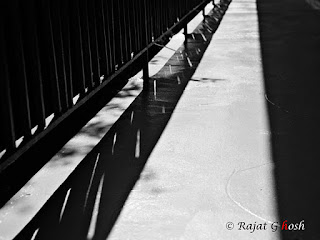
Constancy:the shape of an object focused upon the retina will not be an exact copy of that object’s shape in the physical world. And when we move, the retinal image of the object we see continually changes in size and shape. But, we remain unaware of this change and our immediate visual experience remains integrated and continuous. In addition to changes in size and shape, this process of maintaining visual continuity also takes place in our perceptions of color, brightness, and contrast. The concept that describes our experience of perceptual sameness is called, constancy.
We depend upon constancy so much that the workings of constancy occur almost completely apart from our conscious awareness. It is only when we make perceptual miscalculations, experience illusions, or actively attend to the experience of constancy that we become aware of its importance to our lives.
Size and shape constancy. As familiar objects (e.g. cars) recede into the distance, our brain tells us that the actual size, shape and orientation of these objects remain constant even though the information hitting our retina changes. When size and shape constancies are at work, the process affects the vertical, horizontal and oblique dimensions of our visual orientation without our conscious realization.
Constancy of brightness, color and contrast. The process of constancy allows us to experience everyday transitions of light and color as a smooth continuous process. When we enter a room illuminated by a different level of brightness and color temperature than the room we left, we may briefly be aware of a difference but very quickly we adapt and the color becomes more normal. While constancy is very helpful in these situations, it works against us when we need to accurately evaluate levels of light, color and contrast in a scene. This is where light meters and other tools help us to keep constancy under control.
The Aperture
f/Stops and t/Stops Depth of Field
The Aperture diameter of a lens controls the amount of light striking the film and it also influences the depth of field (see below).
f/Stops and t/Stops
f/stops describe the relationship between the length of a lens and the size of the lens aperture. The math used to derive f/stops is based on a very simple formula : the focal length of the lens divided by the lens diameter.
Take for example a 100mm lens. If you were to measure the diameter of that lens and found, for example that it was 50mm, and then you divided that length (100mm) by its diameter (50mm), you would get a 2. This indicates that the widest possible aperture for that lens would be 1⁄2 of its length, a factor of 2, hence f/2. If the diameter of that 100mm lens was only 25mm, then the widest aperture would be 1⁄4 of its length, hence f/4. When we stop down or open up the lens aperture to decrease or increase the light hitting the film, we are changing the mathematical relationship between lens length and lens diameter. These changes are represented by sequential f/stop numbers where an f/2 indicates a wide opening and an f/22 indicates a very narrow opening. The point to remember is that the f/number represents a fraction. That is why the f/numbers get bigger as the size of the aperture decreases.
t/stops describe the Transmission speed of a lens. To get t/stops, the lens manufacturer measures the actual amount of light that a lens transmits at each f/stop and makes corrective adjustments with the markings on the lens. Since lenses tend to reflect, adsorb and refract light, there will tend to be discrepancies between the mathematical derivations of f/stops and the actual light transmission of a lens. The t/stops correct for that discrepancy. In actual practice, f/stops are used to calculate depth of field and t/stops are used to set exposure.
Full stop f sequence: Each f/stop number in sequence below represents a change of one full stop.
1/ 1.4 /2 2.8/ 4/ 5.6/ 8/ 11/ 16/ 22/32
So if you are still reading, here comes more knowledge.
In life as we see, the perception is what we see with, not just at the retina, so in all possibility there are little you’d that’s inside u watching the scene.
Perception is a active process we require content, we expect constancy:
Size and shape
Color
Expectation and context
We are not in contact with the real world; out senses are the ones that bring the experience to us.
moving on to tech stuff:
tv: aspect raios are : 4 : 3 or 1.33 : 1 is standard
16 : 9 or 1.78 :1 is HDTV
In anamorphic lenses. It squeezes in the image while shooting, and in projection it de squeezes the image, I have a idea, in DHOOM 2, ash looks so lean and all the character looks lean as they left the anamorphic on, n projected without de-sqeezing the image, ME thinks
Talking about lenses:
Wide angle lenses: pull in from the side, and push the front further back
Telephoto compresses space and magnifies, shallow depth of field.
Remember Lenses actually like to focus further away,
Further you focus more the lens likes it,
How near you focus affects the depth of field.
Sharpness is Physiological perception of resolution.
The Red camera believes that resolution is the main and the ARRi system believes the resolution is not necessarily what you need the most of
Remember a sharper lens will give a lower contrast image and a higher contrast image is because the resolving power of the lens is poorer.
And lastly if you want the sun in the shot to be a ball, then you shoot with a wider aperture (open) and use Neutral density filter, else it will break up into beams if u use a smaller aperture.
No comments:
Post a Comment